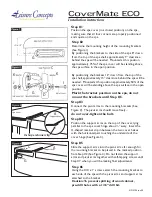
ELECTRIC VEHICLE MANAGEMENT SYSTEM V3
ZERO EMISSION VEHICLES AUSTRALIA
Error Detection
The EVMS monitors a wide range of operating parameters for your electric vehicle and can
notify you if any exceed their safe range or any faults are detected. In most cases, errors
can be acknowledged/dismissed by tapping on the screen. Critical errors are responded to
automatically (such as by shutting down the traction circuit due to an undervoltage cell),
while others are at the driver’s discretion to respond to (such as over-temperature warnings).
The following table describes the errors you may encounter.
Error
Description
Overcurrent Warning
If battery current exceeds the programmed threshold for more
than 1 second, this warning will appear.
Overcurrent Shutdown
As above, except the EVMS will also automatically shut down
the traction circuit if this threshold is exceeded. Note that
for safety reasons this system cannot replace a physical fuse,
though it can be used to prevent blowing the fuse first.
BMS - Low Cell
A BMS module has reported a cell voltage below the minimum
threshold. This error will likely first start appearing under heavy
acceleration, then with increasing frequency. It is recommended
that you pull the vehicle over as soon as safe to avoid a forced
shutdown.
Shutdown by BMS
A low cell condition has been present for more than 10 seconds,
so the EVMS has shut down the traction circuit to protect the
batteries.
BMS - High Cell
A BMS module has reported a cell voltage above the maximum
threshold.
Charge Ended by BMS
A high cell condition has been present for more than 1
second, so the EVMS has shut down the charger to protect the
batteries.
BMS - Overtemp
A BMS module has reported a temperature above the
programmed threshold, and the system will be shut down for
protection.
BMS - Undertemp
A BMS module has reported a temperature below the
programmed threshold, and the system will be shut down for
protection.
Low Battery Charge
The battery’s State of Charge has reached the programmed
warning threshold.
Over-Temperature
The EVMS’s temperature sensor has reported a temperature
above the programmed warning level.
Isolation Fault
A chassis leakage above the programmed threshold has been
detected. (May indicate an insulation fault with traction circuit
wiring or even water ingress into the motor or other device.)
Low 12V Battery
The voltage of the 12V auxiliary battery (power supply for the
EVMS) has dropped below the programmed threshold. May
indicate a weak battery or faulty DC/DC converter.
Precharge Failed
Displayed if an error is detected during the precharge sequence,
either failing to start (usually a wiring fault) or taking too long to
finish (usually an unexpected load “downstream” from the main
contactor). The startup sequence is cancelled automatically.
Contactor fault
If using contactors with auxiliary switches and a discrepancy
is detected (contactor closed when it should be open, or vice
versa), this error will be displayed.
BMS - Comms error
If the EVMS hasn’t received data from a BMS module for a while
(about 1 second), this error will appear and the traction circuit
will be shut down for safety.
No comms to EVMS
If the Monitor hasn’t received data from the EVMS for more
than 1 second, this error will appear. Most commonly this is
due to a wiring fault on the CAN bus.
Corrupt Settings
Occurs if memory corruption has been detected in the EVMS
or Monitor’s saved settings. They will automatically be reset to
defaults. Contact us if you see this one.
Voltage Thresholds
By default the EVMS will come with BMS voltage thresholds configured to suit LiFePO4
cells, but the thresholds can be changed to suit any lithium chemistry. The following table
lists recommended voltage thresholds for Lithium Iron Phosphate (LiFePO4), Lithium Cobalt
(LiCo) and Lithium Titanate (LTO) cells. Most other lithium chemistries (LiPo, NMC, etc) are
variations of Lithium Cobalt and share the same voltage range, but if in doubt please refer to
the datasheet for your batteries to confirm.
Chemistry
Nom Voltage Min Voltage Max Voltage
Charge To
Temp Range
LiFePO4
3.2V
2.5V
3.8V
3.65V
-20˚C – 60˚C
LiCo
3.7V
3.0V
4.2V
4.1 – 4.2V
-20˚C – 60˚C
18
17




























